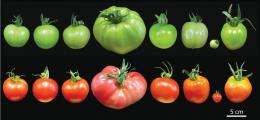Know your tomatoes

Genetically modified (GM) tomatoes look much the same as traditional varieties (Fig. 1). But are they? By comparing the chemical diversity of strains of GM tomatoes with a control strain and traditional reference cultivars, a research team in Japan has developed a way to distinguish between them.
Consumers need to be confident that GM tomatoes are safe, so initial risk assessments must show that they are ‘substantially equivalent’ to traditional varieties in their chemical make-up. Scientists can then focus on those chemicals, or ‘metabolites’, found only in particular GM varieties for toxicological testing.
As a case study, the team—led by Kazuki Saito of the RIKEN Plant Science Center in Yokohama—focused on GM tomatoes over-expressing a foreign gene encoding miraculin, a substance normally found in a tropical plant but not tomatoes. Miraculin is a glycoprotein—a protein with short carbohydrate side chains. It has the remarkable ability to make sour foods taste sweet. “Miraculin has fewer calories than sugar and has potential as a natural sweetener and flavor enhancer,” Saito notes.
Metabolism refers to the processes involved in maintaining life, including the building and breakdown of proteins, nucleic acids and carbohydrates. Complex metabolic pathways involve many enzymes and the chemical constituents of cells and tissues are in constant flux.
Whereas genomics provides an overview of the genetic composition of an organism, ‘metabolomics’ can give a snapshot of biochemical status. “We applied metabolomic techniques to compare the chemical diversity of GM tomatoes to that of traditional varieties,” Saito explains. Because there is currently no single technique for separating and characterizing all metabolites, the researchers used a range of metabolomic techniques to assess the chemical diversity of GM tomatoes over-expressing miraculin.
“Our multi-platform approach allowed us to identify metabolites in both types of tomato in an automated manner, and to evaluate variation between them using robust statistical methods,” says Saito.
The researchers found that the ripening GM tomatoes had a reproducible metabolic signature, and that over 92% of their metabolites showed an acceptable range of variation similar to that of the traditional varieties.
“Our aim was not to show that the GM tomatoes are safe, but rather to examine the chemical diversity of GM tomatoes compared with natural variants, and to possibly narrow down the list of potentially problematic metabolites as a guide to further investigation,” explains Saito.
The team believes that their multi-platform approach could be applied to any GM organism as a start to objective risk assessment.
More information: Kusano, M., et al. Covering chemical diversity of genetically-modified tomatoes using metabolomics for objective substantial equivalence assessment. PLoS ONE 6, e16989 (2011). www.plosone.org/article/info%3Adoi%2F10.1371%2Fjournal.pone.0016989
Provided by RIKEN

















